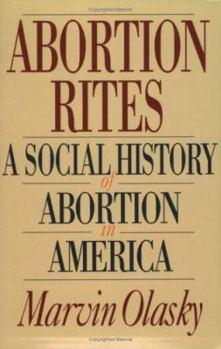Abortion Rites: A Social History of Abortion in America
Select Format
Select Condition 
Book Overview
An in-depth analysis of America's history of abortion before 1960 by a Christian historian. A compelling work that has impacted the ongoing abortion debate.
Format:Paperback
Language:English
ISBN:0891076875
ISBN13:9780891076872
Release Date:September 1992
Publisher:Crossway Books
Length:320 Pages
Weight:0.78 lbs.
Dimensions:0.9" x 6.0" x 9.0"
Customer Reviews
1 rating
An Early American Quilt of Death
Published by Thriftbooks.com User , 15 years ago
While not a history scholar, I would consider myself an amateur student of history. As I read and study history, I purposely aim for breadth. Focusing on one specific area of historical reading gives good depth, but often that depth is obtained with blinders to other formative areas that impacted that particular area of study. It is for that reason that I read a variety of histories--theological, religious, national, regional, political, ecclesiastical, military, and topical. Because of that broad base I may not have depth of knowledge in a particular area, but I tend to be pretty well versed in the big-picture. With that understanding as background, I was surprised to realize how little I knew about the history of abortion in America. To be perfectly frank, the entry point of my mental reference for abortion has always been Roe v. Wade. My typical thinking has been that Roe v. Wade came as a direct result of the feminist movement and so-called sexual revolution of the 1960s. In a way it did, but as Marvin Olasky points out in this book, the history tells a much deeper story. The history which Olasky terms "an early American quilt of death," begins in colonial America in 1629. Of course, records are scarce and the connection between them can easily be misinterpreted, but Olasky links together early court testimonies that weave a sordid tale of infanticide and pregnancy concealment. The crimes appeared to be rare, but were common enough that laws were enacted to legislate against them and prescribe punishments for them. It is interesting that the men involved were often held more culpable than the women. While tracing the history of abortion in America is the backdrop, the author has a purpose in mind. His desire is to show the relationship between legislation and abortion. The goal of the book is to show that legislation, while necessary, is not the primary deterrent for abortion. As abortions increased exponentially in antebellum America, legislation began to proliferate. In the post-war years, zealous application and enforcement of the new laws began to have an effect, but at best, the effect was limited and temporary. Through the use of historical records, Olasky shows that abortions are only decreased through a combination of legislation and compassionate prevention. Unlike politically liberal methods of prevention (birth control and sex education), Olasky's methods are primarily related to prenatal care such as crisis pregnancy centers, job training for single mothers and halfway homes for mothers in trouble. Not only does this book provide historical context to the abortion question, it is also for those who have a sincere desire to see the number of abortions in America reduced. Political conservatives who are frustrated with the current rollback of pro-life legislation can take comfort in the fact that legislation is, at best, only part of the solution. Legislation can only be minimally impacted by most people, but anyone can directl





